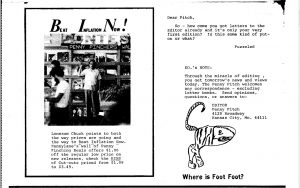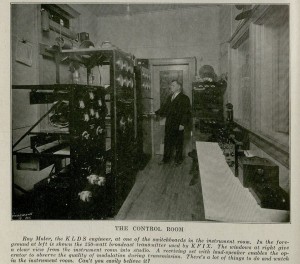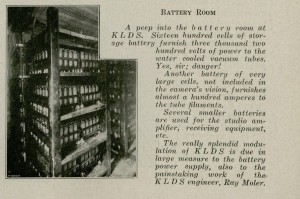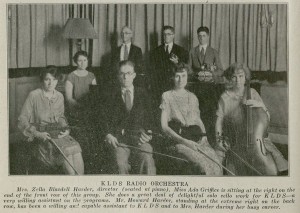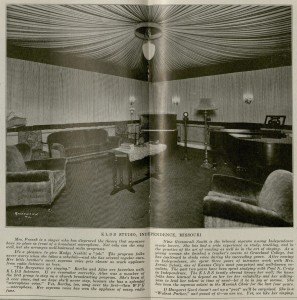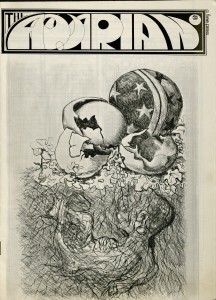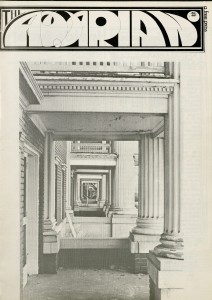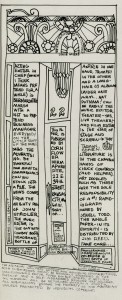“The Pitch was first published in July 1980 as the Penny Pitch, a music sheet handed out by Penny Lane, the erstwhile Westport record store at 4128 Broadway. The first 13 issues were printed under the early banner before undergoing a series of name changes – including KC Pitch and Pitch Weekly – beginning in January 1982. Since then The Pitch has expanded into an alternative weekly newspaper serving the greater metropolitan area and covering music, film, arts, entertainment, news and investigative reporting.”
The above quote is from a 2010 online exhibit made by LaBudde Special Collections to commemorate thirty years of The Pitch. Now, as the paper changes back to a monthly format, we thought it appropriate to revisit that exhibit. In this post, we’ll take a closer look at some of the historical, insightful, colorful, and even unusual stories that made the pages of The Pitch in the 1980s.
The first issue of Penny Pitch came out in July 1980. Clearly the paper had a long evolution ahead of it. The two top headlines were a tanning contest sponsored by KY102, and an interesting story by editor Warren Stylus about Penny Lane’s unique stock of records (Stylus being either a pseudonym, or a perfect last name for a music writer). The tanning contest seems to have been underwhelming, a fact the writer attributed to ash from Mt. St. Helens still blocking out the sun over Kansas City. For those who may not remember, Mt. St. Helens had erupted just a few weeks prior in May, 1980. Stylus’ story is more interesting. He chronicles the story of The House, an important distributor of small independent record labels – over 350 according to Stylus. The House had a colorful history, first occupying an actual house in St. Louis, then the limestone caves around 31st St in Kansas City, before finding a home in the same building as Penny Lane. As with any first issue, the writers were finding their feet. Still, the paper established some columns and segments that would become stalwarts over the next decade. One example was the music review column known as “Ridin’ With the King” written by Leroy “LeRoi” Johnson.
By 1984, the paper (now the KC Pitch) was a more serious piece. In contained interviews with major musicians, advertising for Penny Lane, and an extensive music calendar. With Stevie Ray Vaughan, Van Morrison, Robert Cray, and the Grateful Dead all coming to town in 1984, it was a good time to be a music fan in Kansas City.

LeRoy “LeRoi” Johnson kept Kansas City music fans well informed on both the good and the bad of newly released records.
LeRoy Johnson continued to write music reviews as well. In his reviews he put a (literal) stamp of approval (“WOW”) next to records he liked, and a stamp of dis-approval (“FLY ME”) next to those he did not.
The cover story for April 1984 was an interview with Jazz legend-in-the-making Ronald Shannon Jackson. Jackson was born in Fort Worth, Texas. He attended Lincoln University in Jefferson City, Missouri where he roomed with piano legend John Hicks. Shannon had formed his own band, The Decoding Society, in 1979. Shannon and his band had just returned from a tour of Asia. Of the tour, Shannon said “we were invited to do the Singapore Jazz Festival and the Malaysian Jazz Festival…most of the crowds we played for were two, three, four thousand. They have a total thirst for western music.” Shannon also theorized that Asian audiences were more likely to dance to his music because the unconventional beats he used were akin to beats used in Asian musical genres. Shannon appears to have believed that in 1984 Asian (or European) audiences had less rigid standards for what constituted “Jazz” than Americans did. As a result, they were more “accepting” of his music, although he also said Americans were getting better. Describing his musical style, Shannon said that “there is no actual lead [instrument]” in his melodies. Instead, his melodies were based on rhythms produced by traditional “background” instruments like drums or bass. In Shannon’s songs, “the drums are like a lead instrument.” The Shannon interview demonstrates how America’s signature art form – Jazz – continued to be modified by innovative performers. Critically, it also shows how worldwide audiences were attracted to American music, even if that music did not fit more rigid American audiences’ definitions. Kansas City’s jazz heritage is often thought of as an American phenomenon, but Kansas City takes on global significance when you consider jazz as an important American cultural export. The Shannon interview hints at this relationship.
In October 1988, ahead of a solo appearance by Robert Plant, the KC Pitch asked “Does Kansas City hate Led Zeppelin, or does Led Zeppelin hate Kansas City?” Apparently, in 1969, the crowd at a Zeppelin show at Kansas City’s Memorial Hall booed them off the stage. This, according to writer Anthony Henge, became the first and last time Zeppelin played Kansas City until Plant and Jimmy Page made separate appearances in 1988. By 1988, the paper had grown to over 30 pages long. What had been a simple newsletter for a record store had become arguable the important source of entertainment news in the city. But, some things had stayed the same. LeRoi was still writing music reviews. Some of the articles still had a tongue-in-cheek style. And the paper was (and is) still free.
Sources
Youtube
Paul F. Berliner, Thinking in Jazz: The Infinite Art of Improvisation. (Chicago: University of Chicago Press, 1994)

